ESP MITSUBISHI PAJERO IV 2011 Owners Manual
[x] Cancel search | Manufacturer: MITSUBISHI, Model Year: 2011, Model line: PAJERO IV, Model: MITSUBISHI PAJERO IV 2011Pages: 377, PDF Size: 29.43 MB
Page 16 of 377
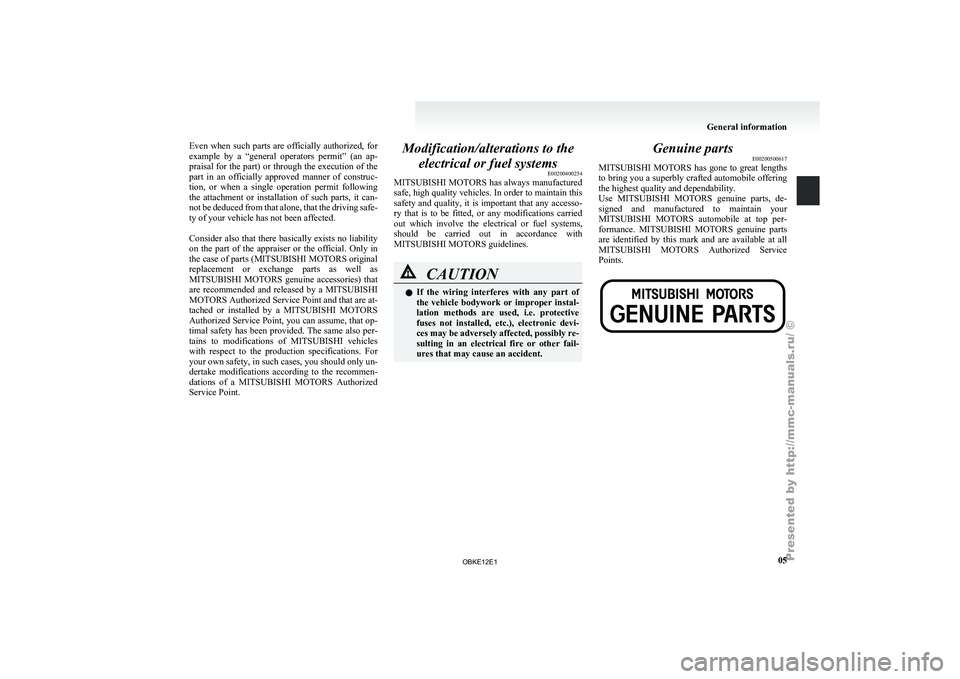
Even when such parts are officially authorized, for
example by a
“general operators permit” (an ap-
praisal for the part) or through the execution of the
part in an officially approved manner of construc-
tion, or when a single operation permit following
the attachment or installation of such parts, it can-
not be deduced from that alone, that the driving safe-
ty of your vehicle has not been affected.
Consider also that there basically exists no liability
on the part of the appraiser or the official. Only in
the case of parts (MITSUBISHI MOTORS original
replacement or exchange parts as well as
MITSUBISHI MOTORS genuine accessories) that
are recommended and released by a MITSUBISHI
MOTORS Authorized Service Point and that are at-
tached or installed by a MITSUBISHI MOTORS
Authorized Service Point, you can assume, that op-
timal safety has been provided. The same also per-
tains to modifications of MITSUBISHI vehicles
with respect to the production specifications. For
your own safety, in such cases, you should only un-
dertake modifications according to the recommen-
dations of a MITSUBISHI MOTORS Authorized
Service Point. Modification/alterations to the
electrical or fuel systems E00200400254
MITSUBISHI MOTORS has always
manufactured
safe, high quality vehicles. In order to maintain this
safety and quality, it is important that any accesso-
ry that is to be fitted, or any modifications carried
out which involve the electrical or fuel systems,
should be carried out in accordance with
MITSUBISHI MOTORS guidelines. CAUTION
l
If the
wiring
interferes with any part of
the vehicle bodywork or improper instal-
lation methods are used, i.e. protective
fuses not installed, etc.), electronic devi-
ces may be adversely affected, possibly re-
sulting in an electrical fire or other fail-
ures that may cause an accident. Genuine parts
E00200500617
MITSUBISHI MOTORS has gone
to great lengths
to bring you a superbly crafted automobile offering
the highest quality and dependability.
Use MITSUBISHI MOTORS genuine parts, de-
signed and manufactured to maintain your
MITSUBISHI MOTORS automobile at top per-
formance. MITSUBISHI MOTORS genuine parts
are identified by this mark and are available at all
MITSUBISHI MOTORS Authorized Service
Points. General information
05
OBKE12E1
Page 21 of 377
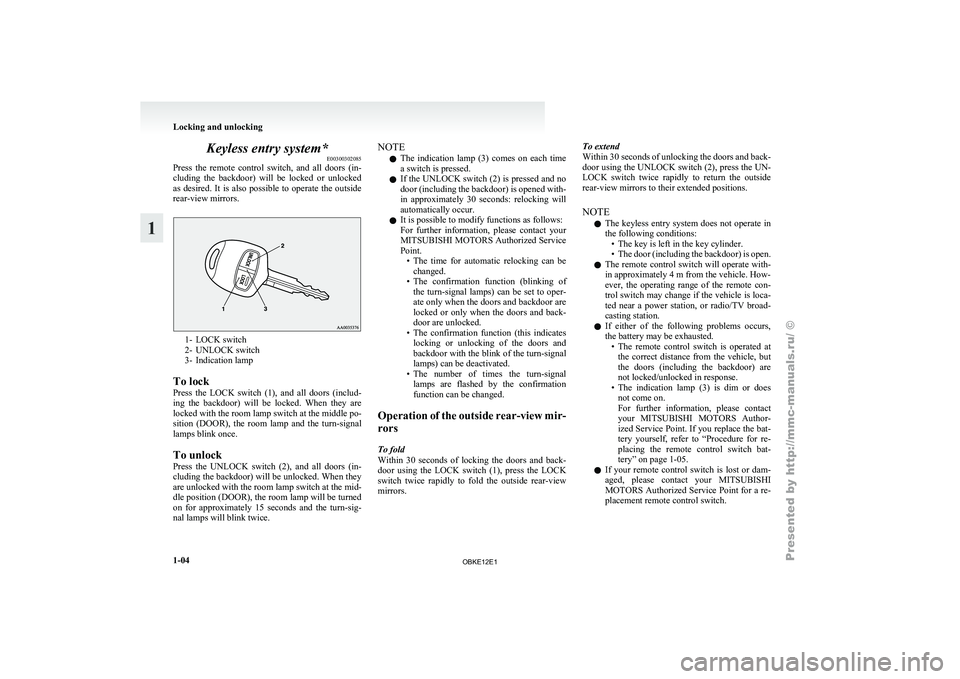
Keyless entry system*
E00300302085
Press the remote
control switch, and all doors (in-
cluding the backdoor) will be locked or unlocked
as desired. It is also possible to operate the outside
rear-view mirrors. 1- LOCK switch
2- UNLOCK switch
3-
Indication lamp
To lock
Press
the LOCK switch (1), and all doors (includ-
ing the backdoor) will be locked. When they are
locked with the room lamp switch at the middle po-
sition (DOOR), the room lamp and the turn-signal
lamps blink once.
To unlock
Press the UNLOCK switch (2), and all doors (in-
cluding the backdoor) will be unlocked. When they
are unlocked with the room lamp switch at the mid-
dle position (DOOR), the room lamp will be turned
on for approximately 15 seconds and the turn-sig-
nal lamps will blink twice. NOTE
l The
indication lamp
(3) comes on each time
a switch is pressed.
l If the UNLOCK switch (2) is pressed and no
door (including the backdoor) is opened with-
in approximately 30 seconds: relocking will
automatically occur.
l It is possible to modify functions as follows:
For further information, please contact your
MITSUBISHI MOTORS Authorized Service
Point.
• The time for automatic relocking can bechanged.
• The confirmation function (blinking of the turn-signal lamps) can be set to oper-
ate only when the doors and backdoor are
locked or only when the doors and back-
door are unlocked.
• The confirmation function (this indicates locking or unlocking of the doors and
backdoor with the blink of the turn-signal
lamps) can be deactivated.
• The number of times the turn-signal lamps are flashed by the confirmation
function can be changed.
Operation of the outside rear-view mir-
rors
To fold
Within 30 seconds of locking the doors and back-
door using the LOCK switch (1), press the LOCK
switch twice rapidly to fold the outside rear-view
mirrors. To extend
Within 30 seconds
of unlocking the doors and back-
door using the UNLOCK switch (2), press the UN-
LOCK switch twice rapidly to return the outside
rear-view mirrors to their extended positions.
NOTE
l The keyless entry system does not operate in
the following conditions:
• The key is left in the key cylinder.
• The door (including the backdoor) is open.
l The remote control switch will operate with-
in approximately 4 m from the vehicle. How-
ever, the operating range of the remote con-
trol switch may change if the vehicle is loca-
ted near a power station, or radio/TV broad-
casting station.
l If either of the following problems occurs,
the battery may be exhausted.
• The remote control switch is operated atthe correct distance from the vehicle, but
the doors (including the backdoor) are
not locked/unlocked in response.
• The indication lamp (3) is dim or does not come on.
For further information, please contact
your MITSUBISHI MOTORS Author-
ized Service Point. If you replace the bat-
tery yourself, refer to “Procedure for re-
placing the remote control switch bat-
tery” on page 1-05.
l If your remote control switch is lost or dam-
aged, please contact your MITSUBISHI
MOTORS Authorized Service Point for a re-
placement remote control switch. Locking and unlocking
1-04
1
OBKE12E1
Page 32 of 377
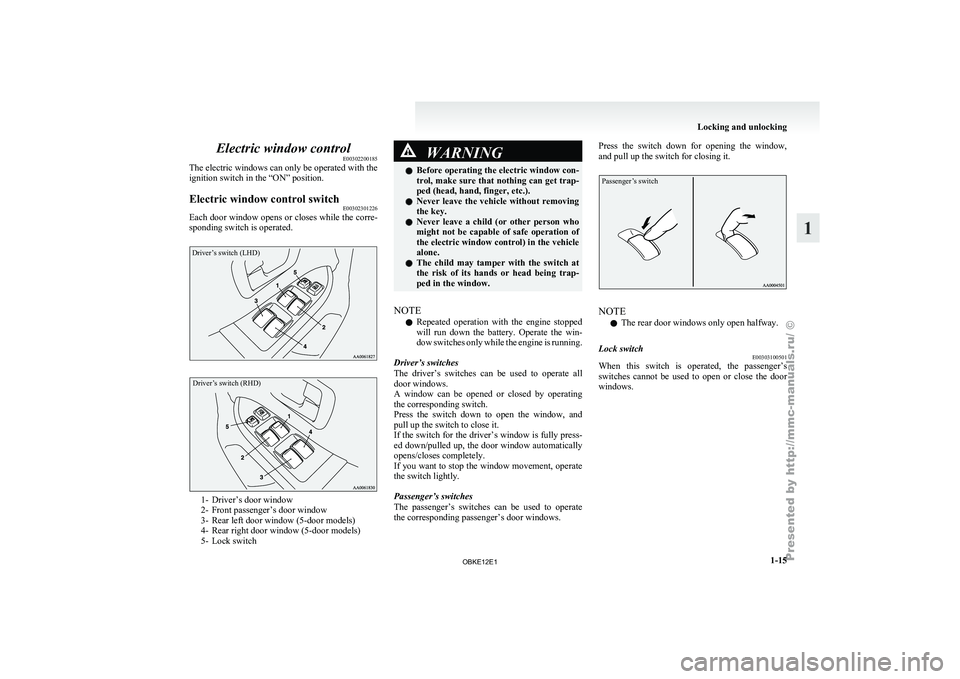
Electric window control
E00302200185
The electric windows can only be operated with the
ignition switch in the “ON” position.
Electric window control switch E00302301226
Each door window opens or closes while the corre-
sponding switch is operated.Driver’s switch (LHD)
Driver’s switch (RHD) 1- Driver’s door window
2- Front passenger’s door window
3-
Rear left door window (5-door models)
4-
Rear right door window (5-door models)
5- Lock switch WARNING
l Before operating the
electric window con-
trol, make sure that nothing can get trap-
ped (head, hand, finger, etc.).
l Never leave the vehicle without removing
the key.
l Never leave a child (or other person who
might not be capable of safe operation of
the electric window control) in the vehicle
alone.
l The child may tamper with the switch at
the risk of its hands or head being trap-
ped in the window.
NOTE l Repeated
operation with
the engine stopped
will run down the battery. Operate the win-
dow switches only while the engine is running.
Driver’s switches
The driver’s switches can be used to operate all
door windows.
A window can be opened or closed by operating
the corresponding switch.
Press the switch down to open the window, and
pull up the switch to close it.
If the switch for the driver’s window is fully press-
ed down/pulled up, the door window automatically
opens/closes completely.
If you want to stop the window movement, operate
the switch lightly.
Passenger’s switches
The passenger’s switches can be used to operate
the corresponding passenger’s door windows. Press the switch down for opening the window,
and pull up the switch for closing it.
Passenger’s switch
NOTE
l The rear door windows only open halfway.
Lock switch E00303100501
When this switch is operated, the passenger’s
switches cannot be
used to open or close the door
windows. Locking and unlocking
1-15 1
OBKE12E1
Page 33 of 377
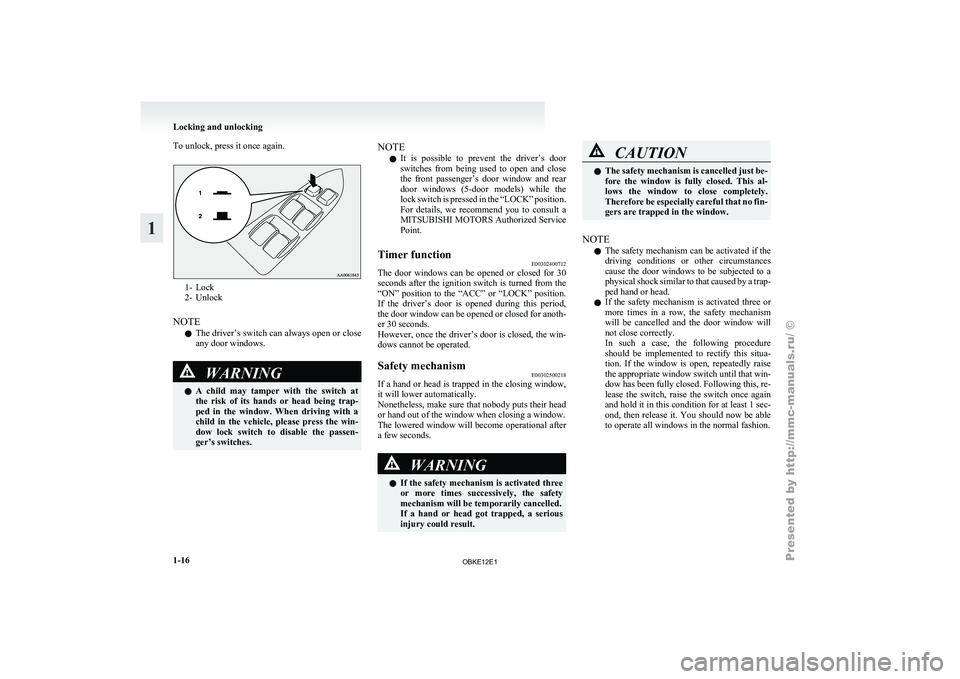
To unlock, press it once again.
1- Lock
2- Unlock
NOTE l The
driver’s
switch can always open or close
any door windows. WARNING
l A
child
may
tamper with the switch at
the risk of its hands or head being trap-
ped in the window. When driving with a
child in the vehicle, please press the win-
dow lock switch to disable the passen-
ger’s switches. NOTE
l It
is possible
to prevent the driver’s door
switches from being used to open and close
the front passenger’s door window and rear
door windows (5-door models) while the
lock switch is pressed in the “LOCK” position.
For details, we recommend you to consult a
MITSUBISHI MOTORS Authorized Service
Point.
Timer function E00302400712
The door windows can be opened or closed for 30
seconds after the
ignition switch is turned from the
“ON” position to the “ACC” or “LOCK” position.
If the driver’s door is opened during this period,
the door window can be opened or closed for anoth-
er 30 seconds.
However, once the driver’s door is closed, the win-
dows cannot be operated.
Safety mechanism E00302500218
If a hand or head is trapped in the closing window,
it will lower automatically.
Nonetheless, make sure
that nobody puts their head
or hand out of the window when closing a window.
The lowered window will become operational after
a few seconds. WARNING
l If the
safety
mechanism is activated three
or more times successively, the safety
mechanism will be temporarily cancelled.
If a hand or head got trapped, a serious
injury could result. CAUTION
l
The safety mechanism
is cancelled just be-
fore the window is fully closed. This al-
lows the window to close completely.
Therefore be especially careful that no fin-
gers are trapped in the window.
NOTE l The
safety mechanism
can be activated if the
driving conditions or other circumstances
cause the door windows to be subjected to a
physical shock similar to that caused by a trap-
ped hand or head.
l If the safety mechanism is activated three or
more times in a row, the safety mechanism
will be cancelled and the door window will
not close correctly.
In such a case, the following procedure
should be implemented to rectify this situa-
tion. If the window is open, repeatedly raise
the appropriate window switch until that win-
dow has been fully closed. Following this, re-
lease the switch, raise the switch once again
and hold it in this condition for at least 1 sec-
ond, then release it. You should now be able
to operate all windows in the normal fashion. Locking and unlocking
1-16
1
OBKE12E1
Page 35 of 377

NOTE
l When
the sunroof
is tilted up, the sunshade
is automatically opened slightly.
To tilt down, press the switch (2). WARNING
l Do not
put
head, hands or anything else
out of the sunroof opening while driving
the vehicle.
l Never leave a child (or other person who
might not be capable of safe operation of
the sunroof switch) in the vehicle alone.
l Before operating the sunroof, make sure
that nothing is capable of being trapped
(head, hand, finger, etc.).
Lock switch E00308900025
When this switch is operated, the sunroof switch
cannot be used to open or close the sunroof.
To unlock, press it once again. 1- Lock
2- Unlock NOTE
l If
the sunroof
switch is operated with the
lock switch pressed, a buzzer sounds to indi-
cate the sunroof cannot be opened or closed.
l With the lock switch pressed, operation of
the electric window control with switches oth-
er than the driver’s door switches is also pre-
vented.
Safety mechanism E00303800090
If a hand or head is trapped in the closing sunroof,
it will reopen automatically.
Nonetheless, make sure
that nobody puts their head
or hand out of the sunroof when opening or closing.
The opened sunroof will become operational after
a few seconds.
If the safety mechanism should be activated 5 or
more times consecutively, normal closing of the sun-
roof will be aborted. In such an event, the follow-
ing steps should be taken: 1. Press the switch (2) repeatedly, setting thesunroof in the tilt up condition.
2. Once the tilt up condition has been reached, press and hold the switch (2) for a period of
at least 3 seconds.
3. Press the switch (2) once again to fully close the sunroof.
4. After pressing the switch (3) to perform full opening, press the switch (2) to fully close
the sunroof. NOTE
l The
safety mechanism
can be activated if the
driving conditions or other circumstances
cause the sunroof to be subjected to a physi-
cal shock similar to that caused by a trapped
hand or head.
l Avoid stopping the sunroof before it reaches
the opening or closing end during operations
in steps 3 and 4 above. If this should acciden-
tally happen, repeat the process from step 1.
5. Following this action, it should be possible to operate the sunroof in the normal manner. CAUTION
l
The safety
mechanism
is cancelled just be-
fore the sunroof is fully closed. This al-
lows the sunroof to close completely.
Therefore be especially careful that no fin-
gers are trapped in the sunroof.
NOTE l The
sunroof stops
just before reaching the
fully open position.
If the vehicle is driven with the sunroof in
this position, wind throb is lower than with
the sunroof fully open.
l When leaving the vehicle unattended, make
sure you close the sunroof and remove the ig-
nition key.
l Do not try to operate the sunroof if it is fro-
zen closed (after snow fall or during extreme
cold).
l Do not sit or place heavy luggage on the sun-
roof or roof opening edge. Locking and unlocking
1-18
1
OBKE12E1
Page 49 of 377

To remove
To remove
the
head restraints, lift the head re-
straint with the height adjusting knob (A) pushed in.
To install
Confirm that the head restraint is facing the correct
direction, and then insert it into the seatback while
pressing the height adjusting knob (A) in the direc-
tion indicated by the arrow. CAUTION
l
Confirm that
the
height adjusting knob
(A) is correctly adjusted as shown in the
illustration, and also lift the head re-
straints to ensure that they do not come
out of the seatback. CAUTION
l
The head
restraints
for the seats differ in
shape and size. When installing head re-
straints, make sure the head restraints
are fitted in their respective seats. Making a luggage area
E00403400013 CAUTION
l
Do not
stack
luggage above the seatback
height.
Secure the luggage firmly.
Serious accidents could result due to un-
restrained objects entering the passenger
compartment during sudden braking.
l When folding, storing or removing the
seat, be sure not to catch your hand or leg.
Folding the rear seatbacks forward (3-
door models) /
Folding the second seat-
backs forward (5-door models) E00403500232
The passenger and luggage compartments can be
joined by folding
the rear (3-door models) / second
(5-door models) seatback forward. This is useful
for carrying long objects.
To fold
1. If your vehicle is equipped with a rear shelf (3-door models) / cargo area cover (5-door mod-
els), remove it before performing the follow-
ing steps. Refer to “Rear shelf (3-door mod-
els)” on page 5-95 and “Cargo area cover (5-
door models)” on page 5-96. Seat and seat belts
2-12
2
OBKE12E1
Page 57 of 377
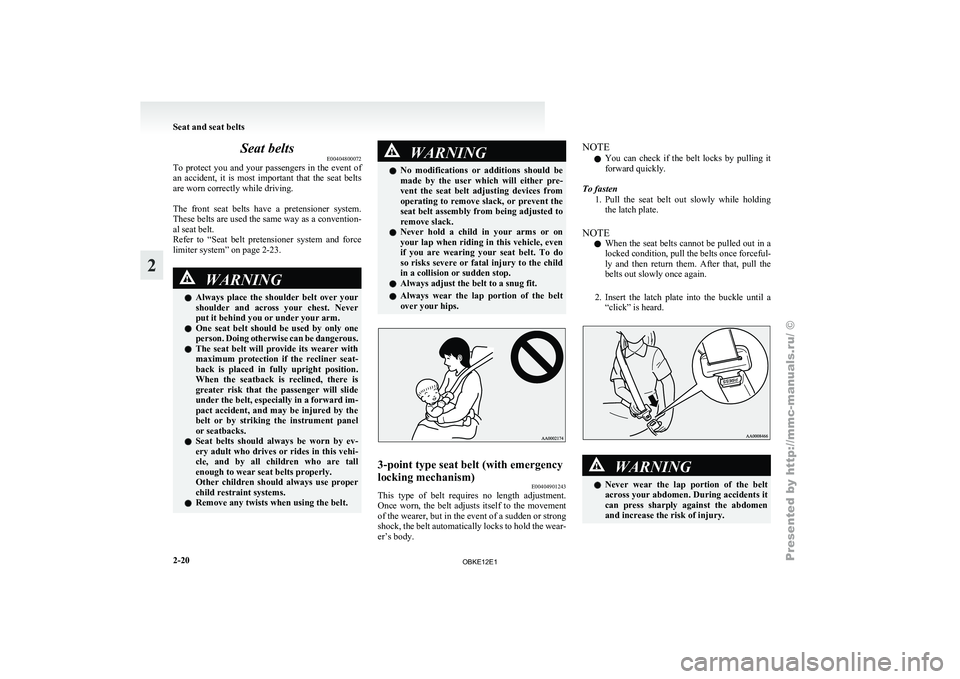
Seat belts
E00404800072
To protect you
and your passengers in the event of
an accident, it is most important that the seat belts
are worn correctly while driving.
The front seat belts have a pretensioner system.
These belts are used the same way as a convention-
al seat belt.
Refer to “Seat belt pretensioner system and force
limiter system” on page 2-23. WARNING
l Always place
the
shoulder belt over your
shoulder and across your chest. Never
put it behind you or under your arm.
l One seat belt should be used by only one
person. Doing otherwise can be dangerous.
l The seat belt will provide its wearer with
maximum protection if the recliner seat-
back is placed in fully upright position.
When the seatback is reclined, there is
greater risk that the passenger will slide
under the belt, especially in a forward im-
pact accident, and may be injured by the
belt or by striking the instrument panel
or seatbacks.
l Seat belts should always be worn by ev-
ery adult who drives or rides in this vehi-
cle, and by all children who are tall
enough to wear seat belts properly.
Other children should always use proper
child restraint systems.
l Remove any twists when using the belt. WARNING
l No modifications or
additions should be
made by the user which will either pre-
vent the seat belt adjusting devices from
operating to remove slack, or prevent the
seat belt assembly from being adjusted to
remove slack.
l Never hold a child in your arms or on
your lap when riding in this vehicle, even
if you are wearing your seat belt. To do
so risks severe or fatal injury to the child
in a collision or sudden stop.
l Always adjust the belt to a snug fit.
l Always wear the lap portion of the belt
over your hips. 3-point type seat belt (with emergency
locking mechanism)
E00404901243
This type of belt requires no length adjustment.
Once worn, the
belt adjusts itself to the movement
of the wearer, but in the event of a sudden or strong
shock, the belt automatically locks to hold the wear-
er’s body. NOTE
l You
can check
if the belt locks by pulling it
forward quickly.
To fasten 1. Pull the seat belt out slowly while holdingthe latch plate.
NOTE l When the seat belts cannot be pulled out in a
locked condition, pull the belts once forceful-
ly and then return them. After that, pull the
belts out slowly once again.
2. Insert the latch plate into the buckle until a “click” is heard. WARNING
l Never wear
the
lap portion of the belt
across your abdomen. During accidents it
can press sharply against the abdomen
and increase the risk of injury. Seat and seat belts
2-20
2
OBKE12E1
Page 60 of 377
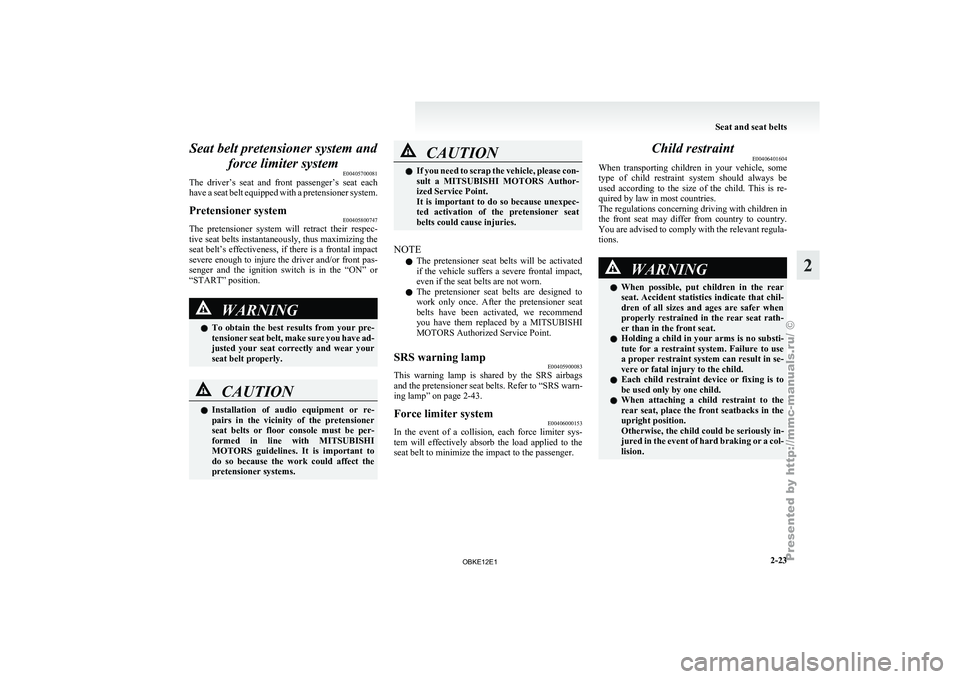
Seat belt pretensioner system and
force limiter system E00405700081
The driver’s seat
and front passenger’s seat each
have a seat belt equipped with a pretensioner system.
Pretensioner system E00405800747
The pretensioner system will retract their respec-
tive seat belts
instantaneously, thus maximizing the
seat belt’s effectiveness, if there is a frontal impact
severe enough to injure the driver and/or front pas-
senger and the ignition switch is in the “ON” or
“START” position. WARNING
l To obtain
the
best results from your pre-
tensioner seat belt, make sure you have ad-
justed your seat correctly and wear your
seat belt properly. CAUTION
l
Installation of
audio
equipment or re-
pairs in the vicinity of the pretensioner
seat belts or floor console must be per-
formed in line with MITSUBISHI
MOTORS guidelines. It is important to
do so because the work could affect the
pretensioner systems. CAUTION
l
If you need
to scrap the vehicle, please con-
sult a MITSUBISHI MOTORS Author-
ized Service Point.
It is important to do so because unexpec-
ted activation of the pretensioner seat
belts could cause injuries.
NOTE l The
pretensioner seat
belts will be activated
if the vehicle suffers a severe frontal impact,
even if the seat belts are not worn.
l The pretensioner seat belts are designed to
work only once. After the pretensioner seat
belts have been activated, we recommend
you have them replaced by a MITSUBISHI
MOTORS Authorized Service Point.
SRS warning lamp E00405900083
This warning lamp is shared by the SRS airbags
and the pretensioner
seat belts. Refer to “SRS warn-
ing lamp” on page 2-43.
Force limiter system E00406000153
In the event of a collision, each force limiter sys-
tem will effectively
absorb the load applied to the
seat belt to minimize the impact to the passenger. Child restraint
E00406401604
When transporting children
in your vehicle, some
type of child restraint system should always be
used according to the size of the child. This is re-
quired by law in most countries.
The regulations concerning driving with children in
the front seat may differ from country to country.
You are advised to comply with the relevant regula-
tions. WARNING
l When possible,
put
children in the rear
seat. Accident statistics indicate that chil-
dren of all sizes and ages are safer when
properly restrained in the rear seat rath-
er than in the front seat.
l Holding a child in your arms is no substi-
tute for a restraint system. Failure to use
a proper restraint system can result in se-
vere or fatal injury to the child.
l Each child restraint device or fixing is to
be used only by one child.
l When attaching a child restraint to the
rear seat, place the front seatbacks in the
upright position.
Otherwise, the child could be seriously in-
jured in the event of hard braking or a col-
lision. Seat and seat belts
2-23 2
OBKE12E1
Page 71 of 377
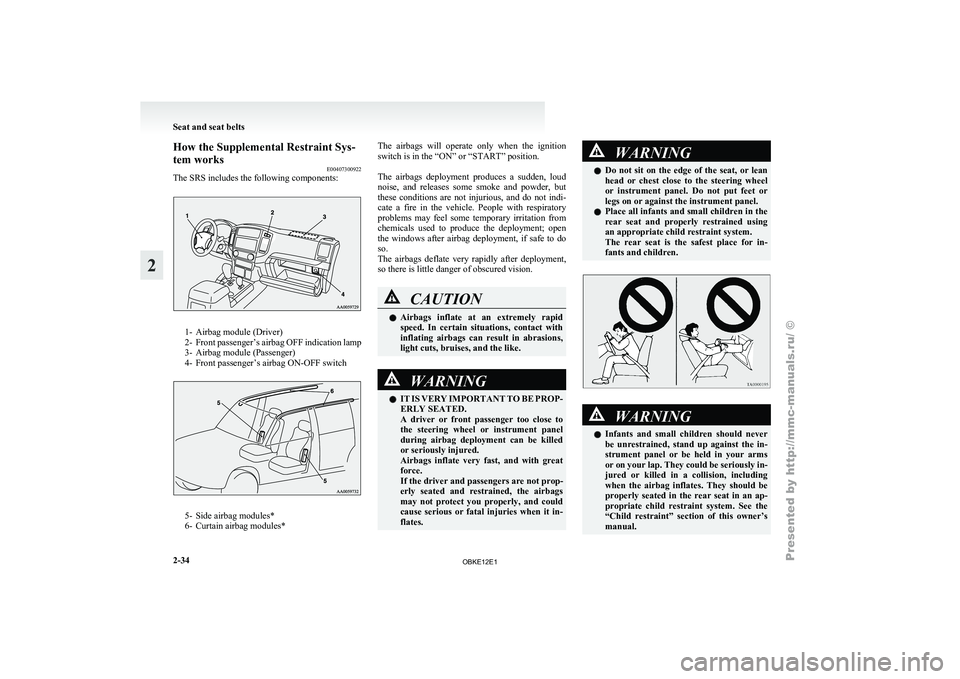
How the Supplemental Restraint Sys-
tem works
E00407300922
The SRS includes the following components: 1- Airbag module (Driver)
2- Front passenger’s airbag
OFF indication lamp
3- Airbag module (Passenger)
4- Front passenger’s airbag ON-OFF switch 5- Side airbag modules*
6- Curtain airbag modules* The
airbags
will operate only when the ignition
switch is in the “ON” or “START” position.
The airbags deployment
produces a sudden, loud
noise, and releases some smoke and powder, but
these conditions are not injurious, and do not indi-
cate a fire in the vehicle. People with respiratory
problems may feel some temporary irritation from
chemicals used to produce the deployment; open
the windows after airbag deployment, if safe to do
so.
The airbags deflate very rapidly after deployment,
so there is little danger of obscured vision. CAUTION
l
Airbags inflate
at
an extremely rapid
speed. In certain situations, contact with
inflating airbags can result in abrasions,
light cuts, bruises, and the like. WARNING
l IT IS VERY
IMPORTANT TO BE PROP-
ERLY SEATED.
A driver or front passenger too close to
the steering wheel or instrument panel
during airbag deployment can be killed
or seriously injured.
Airbags inflate very fast, and with great
force.
If the driver and passengers are not prop-
erly seated and restrained, the airbags
may not protect you properly, and could
cause serious or fatal injuries when it in-
flates. WARNING
l Do not sit
on the edge of the seat, or lean
head or chest close to the steering wheel
or instrument panel. Do not put feet or
legs on or against the instrument panel.
l Place all infants and small children in the
rear seat and properly restrained using
an appropriate child restraint system.
The rear seat is the safest place for in-
fants and children. WARNING
l Infants and
small
children should never
be unrestrained, stand up against the in-
strument panel or be held in your arms
or on your lap. They could be seriously in-
jured or killed in a collision, including
when the airbag inflates. They should be
properly seated in the rear seat in an ap-
propriate child restraint system. See the
“Child restraint” section of this owner’s
manual. Seat and seat belts
2-34
2
OBKE12E1
Page 75 of 377
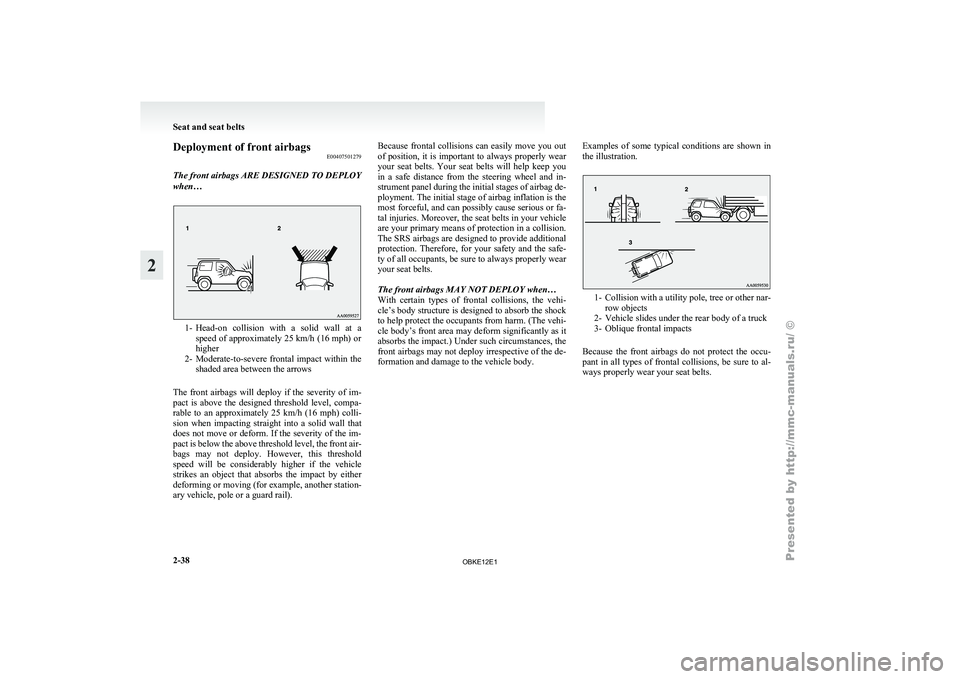
Deployment of front airbags
E00407501279
The front airbags ARE DESIGNED TO DEPLOY
when… 1- Head-on collision with
a solid wall at a
speed of approximately 25 km/h (16 mph) or
higher
2- Moderate-to-severe frontal impact within the shaded area between the arrows
The front airbags will deploy if the severity of im-
pact is above the designed threshold level, compa-
rable to an approximately 25 km/h (16 mph) colli-
sion when impacting straight into a solid wall that
does not move or deform. If the severity of the im-
pact is below the above threshold level, the front air-
bags may not deploy. However, this threshold
speed will be considerably higher if the vehicle
strikes an object that absorbs the impact by either
deforming or moving (for example, another station-
ary vehicle, pole or a guard rail). Because frontal collisions can easily move you out
of position, it
is important to always properly wear
your seat belts. Your seat belts will help keep you
in a safe distance from the steering wheel and in-
strument panel during the initial stages of airbag de-
ployment. The initial stage of airbag inflation is the
most forceful, and can possibly cause serious or fa-
tal injuries. Moreover, the seat belts in your vehicle
are your primary means of protection in a collision.
The SRS airbags are designed to provide additional
protection. Therefore, for your safety and the safe-
ty of all occupants, be sure to always properly wear
your seat belts.
The front airbags MAY NOT DEPLOY when…
With certain types of frontal collisions, the vehi-
cle’s body structure is designed to absorb the shock
to help protect the occupants from harm. (The vehi-
cle body’s front area may deform significantly as it
absorbs the impact.) Under such circumstances, the
front airbags may not deploy irrespective of the de-
formation and damage to the vehicle body. Examples of some typical conditions are shown in
the illustration. 1- Collision with
a
utility pole, tree or other nar-
row objects
2- Vehicle slides under the rear body of a truck
3- Oblique frontal impacts
Because the front airbags do not protect the occu-
pant in all types of frontal collisions, be sure to al-
ways properly wear your seat belts. Seat and seat belts
2-38
2
OBKE12E1